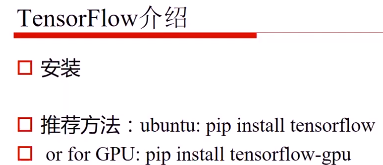深度学习之神经网络(一)
一、深度学习:传统到现在


二、TensorFlow介绍



'''
linear regression experiment, hope you can know:
1. how to design the learning model
2. optimize the model
3. dealing with the dataset
Original Author: Aymeric Damien
Edited by Wei Li for ChinaHadoop Deep learning course
Project: https://github.com/aymericdamien/TensorFlow-Examples/
'''
import tensorflow as tf
import numpy
rng = numpy.random
# model params
learning_rate = 0.02
training_epochs = 3000
display_step=50
#
train_X = numpy.asarray([3.3,4.4,5.5,6.71,6.93,4.168,9.779,6.182,7.59,2.167,
7.042,10.791,5.313,7.997,5.654,9.27,3.1])
train_Y = numpy.asarray([1.7,2.76,2.09,3.19,1.694,1.573,3.366,2.596,2.53,1.221,
2.827,3.465,1.65,2.904,2.42,2.94,1.3])
n_samples = train_X.shape[0]
# tf Graph Input
X = tf.placeholder("float")
Y = tf.placeholder("float")
# Set model weights
W = tf.Variable(rng.randn(), name="weight")
b = tf.Variable(rng.randn(), name="bias")
# Construct a linear model
pred = tf.add(tf.multiply(X, W), b)
# Mean squared error
cost = tf.reduce_sum(tf.pow(pred-Y, 2))/(2*n_samples)
# Gradient descent
optimizer = tf.train.GradientDescentOptimizer(learning_rate).minimize(cost)
# Initializing the variables
init = tf.global_variables_initializer()
# Launch the graph
with tf.Session() as sess:
sess.run(init)
# Fit all training data
for epoch in range(training_epochs):
for (x, y) in zip(train_X, train_Y):
sess.run(optimizer, feed_dict={X: x, Y: y})
# Display logs per epoch step
if (epoch+1) % display_step == 0:
c = sess.run(cost, feed_dict={X: train_X, Y:train_Y})
print("Epoch:", '%04d' % (epoch+1), "cost=", "{:.9f}".format(c), \
"W=", sess.run(W), "b=", sess.run(b))
training_cost = sess.run(cost, feed_dict={X: train_X, Y: train_Y})
print("Training cost=", training_cost, "W=", sess.run(W), "b=", sess.run(b), '\n')
# the testing data
test_X = numpy.asarray([6.83, 4.668, 8.9, 7.91, 5.7, 8.7, 3.1, 2.1])
test_Y = numpy.asarray([1.84, 2.273, 3.2, 2.831, 2.92, 3.24, 1.35, 1.03])
print("Tssting...")
testing_cost = sess.run(
tf.reduce_sum(tf.pow(pred - Y, 2)) / (2 * test_X.shape[0]),
feed_dict={X: test_X, Y: test_Y}) # same function as cost above
print("Test LOSS=", testing_cost)
print("Final Loss:", abs(
training_cost - testing_cost))
三、一些深度学习基本概念
(一)神经元

(二)卷积核


红色代表值比较高,白色代表值比较低。
(三) CNN-卷积神经网络



























 818
818











 被折叠的 条评论
为什么被折叠?
被折叠的 条评论
为什么被折叠?








